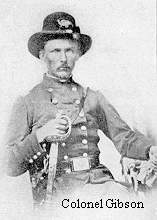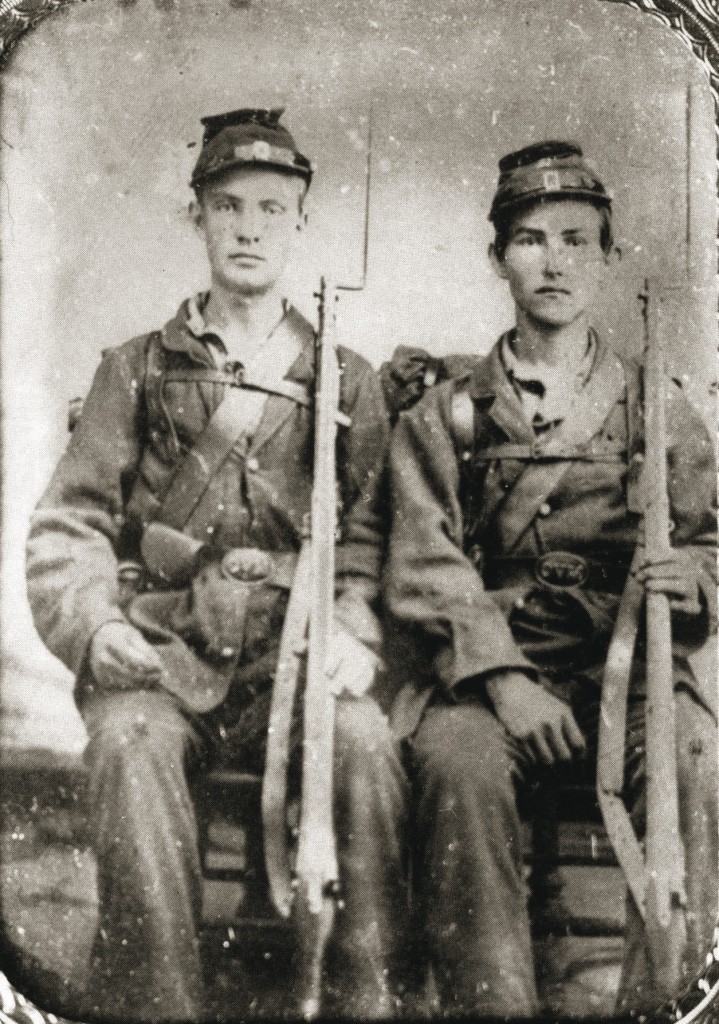Army of the Ohio | 4th Corps, Army of the Cumberland
Engagements:
Shiloh, Tennessee – April 6-7, 1862
Corinth, Mississippi – October 3-4, 1862
Lawrenceburg, Kentucky – October 9, 1862
Dog Walk, Kentucky – October, 9, 1862
Stones River, Tennessee – Dec. 31, 1862, – Jan. 2, 1863
Liberty Gap, Tennessee – June 24, 1863
Christmas Creek, Tennessee – June 24, 1863
Chickamauga, Georgia – September 19-20, 1863
Missionary Ridge, Tennessee – November 25, 1863
Rocky Face Ridge, Georgia – May 5-9, 1864
Resaca, Georgia – May 13-16, 1864
Cassville, Georgia – May 19-22, 1864
Pickett’s Mill, Georgia – May 27, 1864
Kennesaw Mountain, Georgia – June 9-30, 1864
Seige of Atlanta, Georgia – July 28,-Sept. 2, 1864
Lovejoy Station, Georgia – September 2-6, 1864
Columbia, Tennessee – November 24-28, 1864
Franklin, Tennessee – November 30, 1864
Nashville, Tennessee – December 15-16, 1864
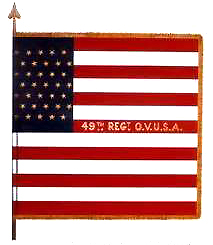 The Forty-Ninth Ohio Volunteer Infantry was organized at Tiffin in Seneca County, Ohio in September of 1861 as a three-year regiment. Colonel William H. Gibson recruited and drilled the regiment at Camp Noble, near Tiffin, then moved to Camp Dennison on September 10th, 1861. Some equipment was issued to the troops on the 21st of September, and they started out for Louisville, Kentucky, where they arrived the following day, and reported to Brigadier General Robert Anderson (formerly commander at Fort Sumter during its bombardment). It was the first organized regiment to enter Kentucky. The reception of this new regiment in Louisville was “cordial” to the extreme as it was not known outside of military headquarters that the regiment was even expected. Two boats, lashed together, neared the wharf as the regimental band performed, and the people of the city received it with enthusiasm, and followed it through the streets to the headquarters of General Anderson. The General appeared on the balcony of the hotel and welcomed the regiment in a short address.
The Forty-Ninth Ohio Volunteer Infantry was organized at Tiffin in Seneca County, Ohio in September of 1861 as a three-year regiment. Colonel William H. Gibson recruited and drilled the regiment at Camp Noble, near Tiffin, then moved to Camp Dennison on September 10th, 1861. Some equipment was issued to the troops on the 21st of September, and they started out for Louisville, Kentucky, where they arrived the following day, and reported to Brigadier General Robert Anderson (formerly commander at Fort Sumter during its bombardment). It was the first organized regiment to enter Kentucky. The reception of this new regiment in Louisville was “cordial” to the extreme as it was not known outside of military headquarters that the regiment was even expected. Two boats, lashed together, neared the wharf as the regimental band performed, and the people of the city received it with enthusiasm, and followed it through the streets to the headquarters of General Anderson. The General appeared on the balcony of the hotel and welcomed the regiment in a short address.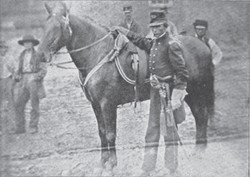
The people of Louisville improvised a magnificent dinner at the Louisville Hotel, and the members of the regiment had a wonderful time. That evening, the regiment took railroad cars for Lebanon Junction, with orders to report to General William T. Sherman. The next morning it crossed the Rolling Fork, wading the river, and marched to Elizabethtown, going into camp on Muldraugh’s Hill. Staying there until October 10th, when it moved on again to Nolin Creek arriving at Camp Nevin.
In the Second Division of the Army of Ohio, the Forty-Ninth was assigned to the Sixth Brigade, commanded by General R.W. Johnson. On December 10th, this division moved towards Munfordsville, on the Green River, and drove the Rebels to the opposite side of the river, and established Camp Wood. On December 17th, pickets from the 32nd Indiana Infantry, on the south side of the Green River, were attacked by Hinman’s Arkansas Brigade and Terry’s Texas Rangers. The 49th Ohio was the first to cross the river, followed by the 39th Indiana in relief of Hinman’s Brigade. The enemy was met and repulsed, with Colonel Terry, one of the Rebel commanders, being killed.
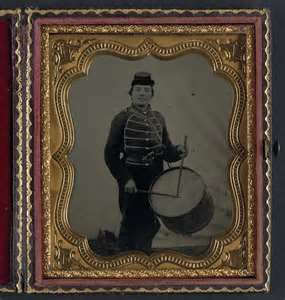 From December 17th to February 14th, the regiment spent time drilling in camp. On February 14th, 1862, it left camp and moved on towards Bowling Green. After some delay in getting across the river, it marched towards Nashville, reaching there on March 3rd, and established Camp Andrew Johnson. On March 16th, it moved with Don Carlos Buell’s army to join Grant’s forces at Pittsburg Landing, arriving there on April 6th after the first day’s fighting at Shiloh. The next day, the 49th went into battle at eleven o’clock with its brigade, commanded by Colonel Gibson. The position of the regiment was on the left of the brigade, connecting on the right with Crittenden’s division. Maintaining this position under hot fire from noon until three o’clock in the afternoon, the regiment, with the enemy in full retreat, stacked its arms and lay down to rest. During the battle the regiment twice performed the hazardous movement of changing fronts under fire.
From December 17th to February 14th, the regiment spent time drilling in camp. On February 14th, 1862, it left camp and moved on towards Bowling Green. After some delay in getting across the river, it marched towards Nashville, reaching there on March 3rd, and established Camp Andrew Johnson. On March 16th, it moved with Don Carlos Buell’s army to join Grant’s forces at Pittsburg Landing, arriving there on April 6th after the first day’s fighting at Shiloh. The next day, the 49th went into battle at eleven o’clock with its brigade, commanded by Colonel Gibson. The position of the regiment was on the left of the brigade, connecting on the right with Crittenden’s division. Maintaining this position under hot fire from noon until three o’clock in the afternoon, the regiment, with the enemy in full retreat, stacked its arms and lay down to rest. During the battle the regiment twice performed the hazardous movement of changing fronts under fire.
Following Shiloh, the 49th Ohio participated in the Siege of Corinth, having a sharp fight at Bridge’s Creek, and at other points along the way, and entered Corinth with the army on May 30th, 1862. It was sent in pursuit of the enemy, passing through Jericho, Iuka, Tuscumbia, and Florence, Alabama, crossing the river at the latter point. From there it marched on to Battle Creek, Tennessee. Here began the movement after Braxton Bragg’s Rebel army, which was then entering Kentucky, and threatening Louisville and Cincinnati. This march was made under terrible suffering from the intense heat, lack of water, and shortage of rations.
Reaching Louisville on September 29th, the 49th rested for a few days, then the army resumed its march in pursuit of the enemy. Moving out on the Frankfort Turnpike, through Shelbyville, and driving the enemy before them, Frankfort was reached on October 5th, in time to disperse the Rebel troops gathered there guarding the inauguration of Captain Dick Hawes as Rebel Governor of Kentucky. On the morning of October 7th, the march was resumed, under orders to join the main army, whom they caught up with following the battle of Perryville. During the the march from Louisville to Perryville there was daily skirmishing. At Lawrenceburg and Dog Walk, brisk engagements were fought, and in each the 49th Ohio was conspicuously engaged, under the command of Lieutenant Colonel Levi Drake.
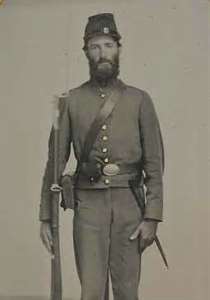 Pursuing the enemy to Crab Orchard, the 49th marched to Bowling Green. From there it marched towards Nashville and on October 5th was with the advance of the siege on that city. It then went into camp at Mill Creek and remained there until December 29th. General Rosecrans, in command of the Army of the Cumberland, started his movement towards Murfreesboro on December 26th. The regiment moved out of Nashville, under Major General McCook, and after constant skirmishing found itself in line of battle on the extreme right of the Union army before Murfreesboro, on the evening of the 30th. At six o’clock the next morning Kirk’s brigade, to the left and front, was furiously assaulted by the enemy, and giving way, was thrown back on the 49th, which became engaged, and was forced back by overwhelming numbers a mile and a half to the Nashville Turnpike, which was reached after incessant conflict of nine hours.
Pursuing the enemy to Crab Orchard, the 49th marched to Bowling Green. From there it marched towards Nashville and on October 5th was with the advance of the siege on that city. It then went into camp at Mill Creek and remained there until December 29th. General Rosecrans, in command of the Army of the Cumberland, started his movement towards Murfreesboro on December 26th. The regiment moved out of Nashville, under Major General McCook, and after constant skirmishing found itself in line of battle on the extreme right of the Union army before Murfreesboro, on the evening of the 30th. At six o’clock the next morning Kirk’s brigade, to the left and front, was furiously assaulted by the enemy, and giving way, was thrown back on the 49th, which became engaged, and was forced back by overwhelming numbers a mile and a half to the Nashville Turnpike, which was reached after incessant conflict of nine hours.
On the following morning the regiment was sent to reconnoiter on the right and rear of the main army. Returning from this duty it rejoined its brigade, and that day was engaged, operating on the extreme right of the army in connection with Stanley’s cavalry. On Friday, January 2d, it occupied a position in reserve, in the center, until late in the afternoon, when upon the repulse of Van Cleve’s division on the left it was ordered, with its brigade, to retrieve the fortunes of the day on that part of the field. It joined in a glorious bayonet charge, which resulted in recovering lost ground and the defeat of the enemy. When the battle opened the entire field and staff of the 49th were present. At its close it was in the command of the junior Captain, S.F. Gray. Because of the capture of General Willich, Colonel Gibson, of the 49th, was given command of the brigade. Lieutenant Colonel Drake was killed while bravely cheering his men, Major Porter was wounded, and all the senior Captains present were either killed or wounded. The regiment now engaged in foraging expeditions, and lost a number of men in encounters with the enemy.
 On June 24th the regiment moved from Murfreesboro’, and at Liberty Gap found the enemy strongly positioned to contest an advance of the Union forces. The First Brigade, to which the 49th was attached, was at once formed in order of battle, and after some maneuvers and hard fighting, the 49th assaulted the enemy’s right, posted on a high hill. It scaled the heights in the face of a severe fire, drove the enemy from that position, and compelled him to fall back to another but equally strong position, about a mile to his rear. On the following day the advance was resumed, other troops taking the lead and engaging the enemy until three o’clock p.m., when the 49th was brought into action on the enemy’s center, which covered the valley, his flanks resting upon the hills. Brigadier General August Willich introduced a new and peculiar drill into the regiment called “Advance Firing”: the formation in four ranks to increase the rate of fire. When within range, at the command, the regiment opened fire, advancing briskly, and soon the enemy’s center was broken, and by the co-operation of other troops the position was occupied. Reaching Tullahoma without further engagement, on July 1st, the regiment went into camp.
On June 24th the regiment moved from Murfreesboro’, and at Liberty Gap found the enemy strongly positioned to contest an advance of the Union forces. The First Brigade, to which the 49th was attached, was at once formed in order of battle, and after some maneuvers and hard fighting, the 49th assaulted the enemy’s right, posted on a high hill. It scaled the heights in the face of a severe fire, drove the enemy from that position, and compelled him to fall back to another but equally strong position, about a mile to his rear. On the following day the advance was resumed, other troops taking the lead and engaging the enemy until three o’clock p.m., when the 49th was brought into action on the enemy’s center, which covered the valley, his flanks resting upon the hills. Brigadier General August Willich introduced a new and peculiar drill into the regiment called “Advance Firing”: the formation in four ranks to increase the rate of fire. When within range, at the command, the regiment opened fire, advancing briskly, and soon the enemy’s center was broken, and by the co-operation of other troops the position was occupied. Reaching Tullahoma without further engagement, on July 1st, the regiment went into camp.
 In August, the Union army started towards Chattanooga, and on the 31st the 49th crossed the Tennessee River near Bellefont. The regiment, under command of Major S.F. Gray, fought in the battle of Chickamuaga, holding a position in the morning of the first day, on the extreme right of the Union forces, forming a part of General R.W. Johnson’s division. Before being engaged the brigade and division were shifted to the extreme left of the army, and joined with Thomas’ corps. At two o’clock p.m. the regiment became engaged with the enemy’s right, posted in a dense woods. A charge was made and the enemy was driven. In this charge the 49th captured two guns. Three guns in all were captured by the brigade. The charge occurred between three and four o’clock p.m. At dusk, the enemy having been reinforced, made a charge. Moving up silently in the darkness, the Rebels gained a point near to and in the front of the Union forces, delivered a withering volley, uttered their demonic yell, and rushed forward with the bayonet. The suddenness of the attack staggered and caused the Union forces to give ground. They quickly rallied however, and the Rebels were repulsed. The 49th retired to the rear and lay down on their arms to rest.
In August, the Union army started towards Chattanooga, and on the 31st the 49th crossed the Tennessee River near Bellefont. The regiment, under command of Major S.F. Gray, fought in the battle of Chickamuaga, holding a position in the morning of the first day, on the extreme right of the Union forces, forming a part of General R.W. Johnson’s division. Before being engaged the brigade and division were shifted to the extreme left of the army, and joined with Thomas’ corps. At two o’clock p.m. the regiment became engaged with the enemy’s right, posted in a dense woods. A charge was made and the enemy was driven. In this charge the 49th captured two guns. Three guns in all were captured by the brigade. The charge occurred between three and four o’clock p.m. At dusk, the enemy having been reinforced, made a charge. Moving up silently in the darkness, the Rebels gained a point near to and in the front of the Union forces, delivered a withering volley, uttered their demonic yell, and rushed forward with the bayonet. The suddenness of the attack staggered and caused the Union forces to give ground. They quickly rallied however, and the Rebels were repulsed. The 49th retired to the rear and lay down on their arms to rest.
On the second day of this battle the 49th Ohio was constantly engaged in various places on the field, and accomplished a brilliant exploit, in connection with Goodspeed’s battery, the 15th Ohio, which some say saved Thomas’ corps from being swept from the field. The enemy had broken through the Union left and were charging for the center, when the 49th faced to the rear and poured into the Rebels a withering fire. From the other side of the circle Goodspeed’s battery and the 15th Ohio delivered a destructive fire, and the enemy was checked and sent back on his main body. When the National forces withdrew that night, the 49th with its brigade was the last to retire. Reaching Rossville it threw up temporary field works, and awaited the approach of the enemy. On the following night it retired into Chattanooga.
On November 24th the 49th joined in the movement against Missionary Ridge. Driving the enemy’s advance line, it reached Orchard Knob, remaining there until the next day. On the 25th, Joe Hooker having accomplished his brilliant movements on the right, while William T. Sherman was pressing the enemy vigorously on the left, the entire center of the Union force was rallied to the charge, and the 49th, with conspicuous gallantry, was among the first to plant its colors on the summit of Missionary Ridge.
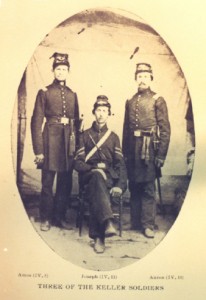 Immediately after this success the regiment moved with Granger’s corps to the relief of Burnside’s forces at Knoxville. This campaign was one of the most severe that the Union forces were called on to endure during the war. The weather was intensely cold, with snow on the ground, the men without adequate clothing and shoes, and their rations exhausted. The march of the army was literally tracked by bloody foot marks. Marching to Strawberry Plains, and hearing that Burnside had repulsed Longstreet, the Union troops returned back to Chattanooga. In the midst of this severe campaign the men of the 49th were called upon to re-enlist for the war.
Immediately after this success the regiment moved with Granger’s corps to the relief of Burnside’s forces at Knoxville. This campaign was one of the most severe that the Union forces were called on to endure during the war. The weather was intensely cold, with snow on the ground, the men without adequate clothing and shoes, and their rations exhausted. The march of the army was literally tracked by bloody foot marks. Marching to Strawberry Plains, and hearing that Burnside had repulsed Longstreet, the Union troops returned back to Chattanooga. In the midst of this severe campaign the men of the 49th were called upon to re-enlist for the war.
Returning to Ohio to enjoy its veteran furlough of thirty days, it was warmly received at Tiffin, where it started out. At the expiration of its furlough the regiment reported at the headquarters of the Fourth Corps at Cleveland, Tennessee, where the Union forces were then concentrating and reorganizing for the campaign against Atlanta. In this arduous campaign the history of the regiment was the same as that of the Fourth Army Corps. It participated in the engagements at Dalton, Resaca, Dallas, Pickett’s Mill, Kennesaw Mountain, Chattahoochie River and Atlanta, exhibiting in every emergency its qualities of courage and discipline, and suffering severely in loss of men, killed and wounded. Joining in the movement that forced the enemy from Atlanta, it participated in the battle at Jonesboro‘ and Lovejoy Station, and abandoning the pursuit of the enemy, returned to camp at Atlanta.
 When the grand army was divided, and General Sherman commenced his march to the sea, the Army of the Cumberland, under General George H. Thomas, was left to attend to the Rebel General Hood, in his mad movement toward Nashville. In the movement of Thomas’ forces the 49th Ohio, under command of Lieutenant Colonel Strong, fully sustained its reputation, participating in the various skirmishes, and the battles of Franklin and Nashville. In the battle before Nashville, on December 15th and 16th, 1864, the regiment participated in several charges made by the Fourth Army Corps, and suffered severely in killed and wounded. After the battle it was part of the column that pursued Hood’s defeated and demoralized forces across the Tennessee River. When the pursuit ended, the regiment went into camp at Huntsville, Alabama, and remained there until about the middle of March, 1865. In that month a movement was made to East Tennessee by rail, going into camp at Greenville. On its return from this expedition to Nashville, it was placed on transports, on June 15th, and taken to Texas by way of New Orleans.
When the grand army was divided, and General Sherman commenced his march to the sea, the Army of the Cumberland, under General George H. Thomas, was left to attend to the Rebel General Hood, in his mad movement toward Nashville. In the movement of Thomas’ forces the 49th Ohio, under command of Lieutenant Colonel Strong, fully sustained its reputation, participating in the various skirmishes, and the battles of Franklin and Nashville. In the battle before Nashville, on December 15th and 16th, 1864, the regiment participated in several charges made by the Fourth Army Corps, and suffered severely in killed and wounded. After the battle it was part of the column that pursued Hood’s defeated and demoralized forces across the Tennessee River. When the pursuit ended, the regiment went into camp at Huntsville, Alabama, and remained there until about the middle of March, 1865. In that month a movement was made to East Tennessee by rail, going into camp at Greenville. On its return from this expedition to Nashville, it was placed on transports, on June 15th, and taken to Texas by way of New Orleans.
Reaching Texas in July, the regiment landed at Victoria and moved to the interior as far as San Antonio, by way of Green Lake and Gonzales. It suffered the hardships of that service for four months, then returned to Victoria, where it was mustered out of service on the 30th of November, 1865.
During the course of the war, the 49th Ohio Infantry had eight officers killed in battle, and twenty wounded (six of these mortally). Of the privates, one hundred and twenty-seven were killed in battle, seventy-one were mortally wounded, one hundred and sixty-five died from disease, and seven died in Rebel prisons at Andersonville and Danville. Six hundred and sixteen were discharged on account of wounds or other disability.
Related Links
The Buckeye Vanguard, History of the 49th Ohio Veteran Volunteer Infantry, 1861–1865
Little Miami Publishing, Milford, OH
Center for Archival Collections: 49th Ohio Volunteer Infantry
48th Ohio Veteran Volunteer Infantry
